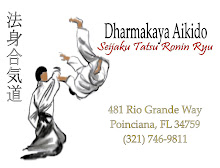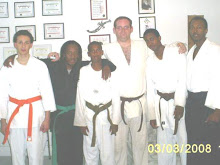Click link above to be directed to Lama Rangdrol's webpage
Ngakpa Sensei

- Silent Dragon
- Poinciana, Florida, United States
- Althought I "attempt" to teach I remain a student and my students become my teachers. I am from East Stuart, Fl (across the tracks) and there the seed was planted. I recieved training in the art of Kenjote Taijutusu from the Honorable Martial Monk Kinjo Takemura Kaijo until his death in 1987, he taught me many things and I loved him. I served in the US Army as an infantryman in the middle east and had the unfortunate opportunity to utilize those skills to return home in one piece, so to speak. For years after that I continued to teach but sought something else and eventually found "it".....AIKIDO. I placed my ragged black belt into the closet and donned the white one, with Kevin Anderson as my guide, I began. Funny now how it seems "it" was here all along.
Tuesday, July 29, 2008
Thursday, May 15, 2008
Various Class clips of a typical night of practice, enjoy and comments welcome
All techniques viewed here are my own personal understandings of practical application of the Fugakukai / Karl Geis Ryu Wazas. This is in no way a display of traditional Karl Geis teachings.
Sunday, March 30, 2008
Perception of Initial Attack and Creating Off-Balance
 The very first principle of Aikido is to get off the line of attack, Tegatana No Kata gives us what we need to practice this principle at our own pace, at our own time, according to our own personal understanding levels. Accomplishing this "first" principle enables us to achieve the second principle of creating and continuing kuzushi, or off-balance, of the attacker.
The very first principle of Aikido is to get off the line of attack, Tegatana No Kata gives us what we need to practice this principle at our own pace, at our own time, according to our own personal understanding levels. Accomplishing this "first" principle enables us to achieve the second principle of creating and continuing kuzushi, or off-balance, of the attacker.This is the most basic practice of Aikido. If this can be accomplished then all of the techniques of Aikido appear without unnecessary force.
When confronted with a true attack, our natural reactions are to move or remain frozen to the spot (Fight or Flight). In our practice, we are training ourselves to "move" and to continue our motion in accordance with the attack until the threat is neutralized or projected safely away from us. To accomplish this we must stay just out of reach of our attacker, while maintaining ma-ai. We do this by moving our center (That means our entire being) off the line, this creates the  initial off balance by "not" being where our attacker "knows" we are. This "mental" off balance precedes the physical. Some effort is required to maintain this physical off balance by over extending the attackers reaction to the "mental" off balance and if we just continue to move with our attacker the "fall or throw" inevitably occurs.
initial off balance by "not" being where our attacker "knows" we are. This "mental" off balance precedes the physical. Some effort is required to maintain this physical off balance by over extending the attackers reaction to the "mental" off balance and if we just continue to move with our attacker the "fall or throw" inevitably occurs.
This will be the focus of the next class. I have observed many times the correct application of a technique during the nijusan kata but observed complete technique failure during randori no kata because of the attempt of a technique when control of the initial off balance is lost. Let's face it, no one is going to let us throw them down or throw themselves down for that matter. We must create an atmosphere where falling is the only option. initial off balance by "not" being where our attacker "knows" we are. This "mental" off balance precedes the physical. Some effort is required to maintain this physical off balance by over extending the attackers reaction to the "mental" off balance and if we just continue to move with our attacker the "fall or throw" inevitably occurs.
initial off balance by "not" being where our attacker "knows" we are. This "mental" off balance precedes the physical. Some effort is required to maintain this physical off balance by over extending the attackers reaction to the "mental" off balance and if we just continue to move with our attacker the "fall or throw" inevitably occurs.Everyone is invited to this class,
Ngakpa Sensei
Ngakpa Sensei
"OM MANI PEME HUNG"
Saturday, March 29, 2008
Class Cancellation
I regret the need to cancel classes until further notice. Wife is having surgery Mon. and will be hospitalized for a couple of days. Will try to resume classes of Thursday, April 3, 2008 for Advanced students and Saturday, April 5, 2008 for All.
Continue to practice Ukemi and Tegatana No Kata, these can be done alone or with a partner.
Continue to practice Ukemi and Tegatana No Kata, these can be done alone or with a partner.
Thursday, March 13, 2008
The Importance of Ukemi
My first art of falling was simply an effort of not getting hurt by my older and much wiser sempai of the Kenjote Taijutsu Ryu. For the first two years under Sensei Takemura all I did was watch and play the role of Uke and in those days we had no mats to land on, only the unforgiving nature of the ground.
Sensei would always say, "Become soft and yield!" I had no idea what he meant. What I did know was that everytime I resisted the throw, things hurt very badly. When I gave up fighting the techniques and realized when I was off balance and became "soft" with the throw, IT DIDN'T HURT. No matter how hard they would throw me (and they would really try to plant you), I was able to get up and continue with another attack.
This realization bought on another: If I became soft with an attack, I could direct it away from me and set my attacker up for all sorts of nasty little things.
So, the art of falling is more than just "falling", it is a way for us to know ourselves, our limitations, and it gives us the tools to overcome all that wishes to harm us.
Some people distinguish falling as the Aikikai way or the Kodokan way, I have no preference as to which my students use as long as it results with a safe landing. I teach ukemi in the manner in which I learned it and that would be classified as the Kodokan way, but let the truth be told, I use both depending on the situation.
What I would like for my students to get is a natural feeling of "going with the flow" of things. This realization will lead to greater randori practices and even better aikidoka. How can we learn to protect ourselves from attack completely if we can't finish the technique completey? We can not if we must stop before the throw. We must practice as we will do, we must be able to follow through with all of our efforts if we are to evolve as martial artist and we can only do this if we have trained and willing partners to learn from.
We must all train hard in ukemi and value its importance, without it our aikido practice fails us. Without it we are simply dancing.
Sensei would always say, "Become soft and yield!" I had no idea what he meant. What I did know was that everytime I resisted the throw, things hurt very badly. When I gave up fighting the techniques and realized when I was off balance and became "soft" with the throw, IT DIDN'T HURT. No matter how hard they would throw me (and they would really try to plant you), I was able to get up and continue with another attack.
This realization bought on another: If I became soft with an attack, I could direct it away from me and set my attacker up for all sorts of nasty little things.
So, the art of falling is more than just "falling", it is a way for us to know ourselves, our limitations, and it gives us the tools to overcome all that wishes to harm us.
Some people distinguish falling as the Aikikai way or the Kodokan way, I have no preference as to which my students use as long as it results with a safe landing. I teach ukemi in the manner in which I learned it and that would be classified as the Kodokan way, but let the truth be told, I use both depending on the situation.
What I would like for my students to get is a natural feeling of "going with the flow" of things. This realization will lead to greater randori practices and even better aikidoka. How can we learn to protect ourselves from attack completely if we can't finish the technique completey? We can not if we must stop before the throw. We must practice as we will do, we must be able to follow through with all of our efforts if we are to evolve as martial artist and we can only do this if we have trained and willing partners to learn from.
We must all train hard in ukemi and value its importance, without it our aikido practice fails us. Without it we are simply dancing.
Subscribe to:
Comments (Atom)




